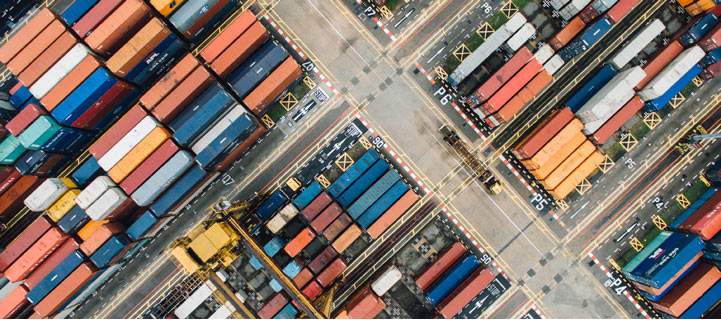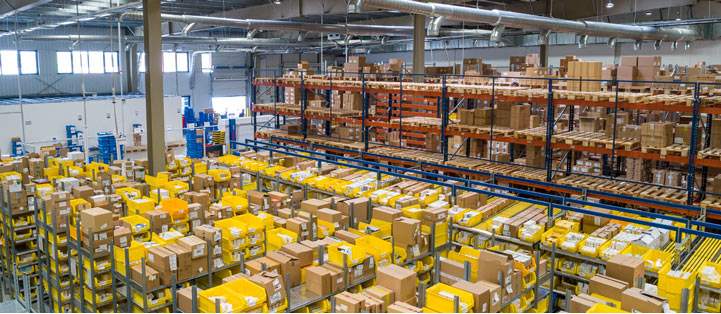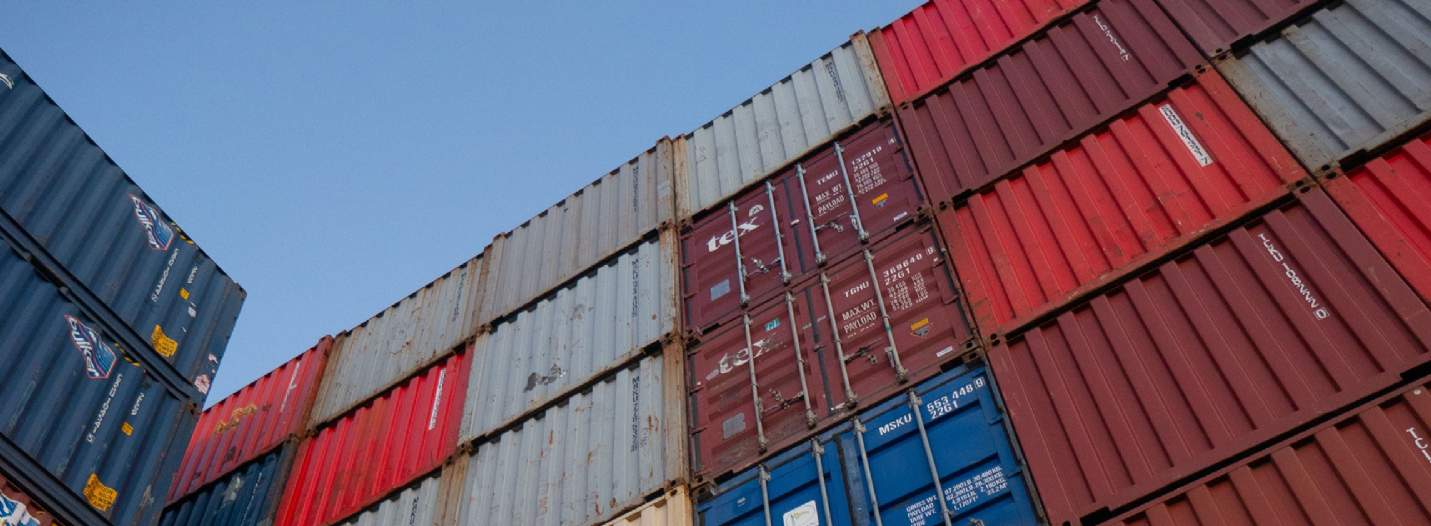European logistics market slows but economic tailwinds are set to return
A mixed economic outlook
The impact of rising interest rates and inflation’s strain on households became increasingly clear in the year’s final quarter. Investor confidence continued to falter in the last months of the year, leading to a not insubstantial decline in annual investment volumes into the sector and a significant decline compared to a record Q4 last year. In the occupier market, slowing consumer demand and rising costs began to hit occupiers, which led to a similar fall in leasing activity across Europe.
Crucially, CPI data from December 2022 shows that inflation appears to have peaked and is now declining in the UK and euro area, as well as the US. In the euro area, this fall has been led by a drop in energy prices, which are now contributing a smaller proportion to inflation than they previously were. While interest rates will inevitably fall at a lag compared to the inflation rates that drove them, it's worth noting that central banks have begun to strike a more dovish tone, suggesting we may be approaching a similar peak in interest rates this year.
While a downturn is still on the cards, many analysts expect it to be less pronounced than initially feared. Indeed, the Citi Economic Surprise Index for the eurozone, which measures the difference between official economic results and forecasts, rebounded from a low point in July 2022 and has since recorded significant outperformance by the bloc relative to expected results.
The logistics sector's fortunes are deeply linked to those of the retail sector, of both the physical and online varieties. Based on long-term averages, retail occupiers in one form or another account for 60% of take-up in the logistics sector, so challenging market conditions online and on the high street will inevitably adversely affect the occupier market. In this respect, declining retail sales relative to the five-year average will certainly alarm many occupiers as consumers reduce spending in the face of the cost-of-living crisis. Similarly, more logistics-heavy online sales have also declined significantly since the end of Covid-era restrictions, potentially reducing occupiers' inventory needs.
Despite the cost-of-living crisis, the consumer economy has so far proven surprisingly resilient and is expected to recover this year. As we previously noted, Oxford Economics forecasts show flat consumer spending growth, a far cry from the negative growth seen in 2009 and 2012. One factor in this appears to be the relatively robust labour market. While the tech sector has seen several high-profile announcements of job cuts, the overall labour market has remained relatively robust, and, more importantly, household unemployment expectations remain positive.
Indeed, while households have been quite dour about the overall economic situation, sentiment around their own financial situation has remained strong, which will provide support for consumption.
The unique situation that Covid-19, and the fiscal stimulus that followed it, creates a challenging paradigm for occupiers. As pandemic savings have unwound and spending has reverted towards long-term trends, occupiers who have built their occupational footprint around Covid-era trends may struggle more than those that took a more conservative approach when trying to future-proof their businesses.

Occupational demand edges up in the final quarter of the year
European logistics take-up reached 8.3m sq m in the final quarter of the year. Considering the economic context, this growth of 3% q/q was an outperformance of expectations. Certainly, there is a noticeable decline in take-up compared to the end of 2021 and the start of 2022. Indeed, despite the uncertainty in the market, take-up remains in line with the quarterly average over the last five years.
Digging further into individual markets, most locations outperformed their five-year averages, even as they posted significant declines compared to Q4 2021’s record quarter
Andrew Blennerhassett, Associate, European Logistics Research
The combination of this resilience and a record-breaking H1 saw year-end take-up total 37.5m sq m in 2022, a total second only to 2021’s series high of 40.2m sq m. This equates to a fall of just 6% year on year in 2022. In annual terms, declines in take-up have been only mild and relatively even across the board, with the exception of large year-on-year increases in smaller markets like Dublin, Madrid and Romania. This has left the composition of take-up by the market more or less in line with 2021.
Digging further into individual markets, most locations outperformed their five-year averages, even as they posted significant declines compared to Q4 2021’s record quarter. Portugal (+94%), Romania (+62%) and Spain (+57%) saw the strongest results relative to their five-year average. France (-4%) was the only market to post a negative result on this metric.
Despite this, many markets now look severely adversely impacted by economic headwinds in the context of their year-on-year growth, with Poland (-37%) and the UK (-47%) all seeing sharp year-on-year declines relative to Q4. That said it must be kept in mind that overall take-up in 2022 was 18% higher than the five-year average.
Record lows in vacancy continue to support rental growth
Strong take-up in 2022 continued to put downward pressure on vacancy rates last year. The overall vacancy rate fell from 3.6% at the end of 2021 to 3.1%, its lowest point in the series.
In the last four quarters, vacancy rates have tightened to 6.3% in Madrid (-300 bps), 4.0% in Romania (-250 bps), and 2.3% in Norway in the final quarter of 2022. In Prague, the vacancy rate has remained below 1% for the last three consecutive quarters, which anecdotally translates to almost no availability of suitable stock for occupiers. We are now seeing vacancy rates begin to rise in some markets, although crucially from record lows. The vacancy rate rose to 3.9% in the UK (+100 bps), and 3.8% in Budapest (+60 bps), and rebounded from a series low in Dublin to 1.6% (+80 bps). Vacancy rates may continue to trend upwards in 2023 as the e-commerce firms that propelled take-up to record heights adapt to lower online sales volumes and, in some cases, reduce their footprint.
Competition for this limited stock has intensified among occupiers as the vacancy rate has declined in recent years. This gave landlords the opportunity to command higher rents for their properties, particularly for modern stock which has been in critically short supply. Across Europe, prime rents grew by 11% in 2022. Annual growth in prime rents was highest in Prague (36%) and Île-de-France (32%) and Upper Silesia (+22%). Rental growth slowed to 2.0% YoY in Warsaw, Madrid, and Stockholm and was flat in Vienna and Budapest.
As we have previously noted, slowing leasing activity will probably be offset by the historically low levels of available space, which are likely to continue to drive rental growth in the short term. With vacancy rates at such low levels at the start of the slowdown and no signs of an oversupply in the construction pipeline, there is room for an increase in occupiers handing back space due to a stronger-than-forecast downturn without leading to a sharp correction in rents.
As our research in the UK shows, transport costs account for a significantly higher share of logistics occupiers' operating costs than rent. This suggests that well-located prime stock will remain in high demand, particularly among occupiers facing rising fuel costs, seeking to increase fuel efficiencies by reducing average journey distance.
Investment volumes drop from record highs
The logistics sector remained appealing to investors in 2022, with investment volumes into logistics assets reaching €54.5bn, a fall of 18% year on year. Similarly to the occupational market, it must be noted that 2021 was a record-breaking year, and therefore a decline in investment volume was always likely, even without the economic volatility we have seen over the last 12 months.
Although the record of 2021 is hard to surpass, the industrial sector continued to attract capital in 2022, with the total industrial volume sitting 24% above the five-year average. This appetite for logistics is reflected by logistics' increasing share of total investment. Our data shows that in 2017, the European logistics investment volume was approximately 13% of total European investment volumes, and this increased to approximately 19% in 2022.
However, 2022’s final figure obscures a significant slowdown of the industrial investment volumes across Europe in the second half of the year, and specifically in the last quarter. The sector benefited from strong momentum in the first half of the year, with total investment volumes rising by 59% compared to the five-year average.
Momentum slowed in the second half of the year as rising interest rates and the ensuing increase in financing costs led to investors becoming more skittish in the second half of the year. Our data shows that 62% of the total investment volume in 2022 is related to deals that closed in the first half of the year and 38% in the second half of the year. In contrast, a typical H2 accounted for 57% of annual investment volumes in the last five years. v
A closer investigation shows that the total industrial investment volume in the last quarter of the year totalled €8.6bn, which is flat quarter-on-quarter (-1%), but represents a fall of 69% compared to Q4 2021 and down by 42% on the five-year (Q4) average. While investment in Q3 typically slows for seasonal reasons, Q4 accounted for 39% of annual volumes over the last five years. From this, we can see that investors started to put their foot on the brake in Q3 of 2022 and hit the brake hard by year-end.
Although these declines in volumes in the last quarter of the year were seen across Europe, the countries with the biggest quarter-on-quarter declines were Ireland (-92%), France (-66%), Norway (-62%), and the UK (-48%). Only three markets: Sweden (+79%), the Netherlands (+56%), and Denmark (+17%) saw industrial investment volumes increase quarter-on-quarter. Even these markets are down relative to the record Q4 total in 2021, year-on-year comparisons with Q4 show declines of -59%, -23%, and -78%, respectively.
Looking at who the biggest buyers and sellers were in the last quarter of the year, we see, and perhaps unsurprisingly, the big investors (GIC, Blackstone, and ICG) that generally have more dry powder available to pick up assets against a discount further increasing their market share in the industrial sector. Whilst on the seller side, we saw a mixture of investors and developers disposing of some of their assets to ensure liquidity.
The gap in expectations between sellers and buyers that we witnessed in the third quarter of 2022 widened further in Q4, resulting in a significant drop in deals closing. This, in turn, decreased the availability of transactional evidence, making it harder to discern where pricing was at the close of the year and increasing the disparity between sellers’ and buyers’ pricing expectations. When faced with economic uncertainty and an increasingly opaque market, investors tend to shift their capital to core assets in their domestic markets, which they typically have a better understanding of and are perceived to be more resilient to market fluctuations. For some investors, this may represent a safe haven until market conditions become favourable again for non-domestic and more value-add or opportunistic investment opportunities.
The limited transactional evidence that came to light in Q4 2022 showed that prime industrial yields moved out further, with the European average reaching 4.69% in the last quarter of 2022, an increase of 40 bps compared to Q3 2022 and nearly 70 bps compared to a year earlier.
The (core) Western European markets saw the greatest upward pressure on average prime yields. With the core Western European prime yields increasing to 4.11% and for the rest of Western Europe to 4.43% which are compared to the previous quarter up by 36 bps and 45 bps, respectively, and compared to the same period last year up by 75 bps and 82 bps, respectively. The prime yields in the CEE and Southern Europe regions remained relatively stable only moving out by 10 bps and 9 bps to 5.86% and 5.45% respectively compared to last quarter and 11 bps and 40 bps year over year.
Zooming in further, the markets with the largest yield movements quarter-on-quarter were London (+75 bps), the Dutch markets of Amsterdam, Rotterdam, Schiphol and Venlo all +50 bps, followed closely by the German markets of Berlin, Cologne, Dusseldorf and Hamburg all +40 bps. There were no markets that showed yields moving inwards, and we only recorded yields stabilizing in Warsaw (5.20%), Madrid and Barcelona (4.75%) and Bucharest (7.50%).
On an annual basis, the movement in yields is much more significant, with the largest increases occurring in London (+175 bps), Venlo (+110 bps), Amsterdam, Rotterdam, Schiphol, Prague (all +100 bps), followed by Warsaw (+95 bps) and Berlin, Cologne, Dusseldorf, Hamburg and Munich (all +80 bps).

Tailwinds may be returning
The decline in investment in the latter half of the year is likely to continue into Q1 as buyers and sellers struggle to find common ground in terms of pricing. Anecdotally, our agents have seen some activity from new entrants to the market who are willing to pay sharper yields than incumbent players in the market. Certainly, sentiment among investors has improved in the first months of 2023, but it remains to be seen when bigger players will start to take the plunge.
There are promising signs, however. Investors were waiting to deploy in excess of $750 billion in dry powder globally at the end of 2022. This is an increase of 74% compared to 2019, and it is likely that a not-insubstantial share of this will flow into European real estate assets. Indeed, a survey by the Official Monetary and Financial Institutions Forum GPP found that 89% of respondents are planning to increase or maintain their allocations towards real estate in the next 12–24 months, the highest share of any asset class. Given the industrial sector’s increasing share of total investment volumes in recent years, we would expect to see investors continue to buy into the logistics growth story. This is because the occupational market continues to benefit from tailwinds, both old and new.
The occupational market’s growth story has been characterised by the pandemic era boom in e-commerce, and while this trend has weakened in the last year, we still believe that e-commerce growth is an inevitable progression due to demographic trends, albeit at a slower rate than during the pandemic. Statista estimates that an additional 13.2m shoppers will start using e-commerce in Germany, the UK, France, Italy, and Spain by 2025, having grown by 47m since 2017. One driver of this is that as younger, more tech-savvy generations enter the labour force and generate their own disposable incomes, their medium of choice will, on average, tend more towards online shopping than previous generations. Over the next five years, forecasts also suggest strong growth in online sales in the food sector. This will likely be a boon for logistics demand at the expense of traditional retail.
Another trend that will drive occupier demand is the shift away from long, complicated global supply chains and an increase in onshoring and nearshoring. In the near term, supply chain disruption has seen many occupiers expand their footprint to accommodate a shift from just-in-time to just-in-case inventory strategies, with our own research pointing to increasing inventory sizes as a major challenge amongst occupiers in 2022. In the longer term, we would expect to see greater take-up in the manufacturing and automotive sectors. The UK shows one potential example of this trend, with manufacturing accounting for its highest-ever share of take-up last year.
We would already note a significant increase in the import of intermediate goods, which will undergo additional manufacturing before reaching consumers in Europe. Monthly imports of intermediate goods increased by 17% YoY in October 2022 and by 40% compared to the same period in 2019. Indeed, total imports of intermediate goods in the first ten months of 2022 were 62% higher than the ten-year average. That said, both inventory accumulation and intermediate goods imports are highly pro-cyclical, so there’s potential for significant amounts of noise in this data.
Finally, global shortages in semiconductors have led to concerns about supply chain security. This industry is heavily concentrated in Taiwan, which is subject to increasing geopolitical risk. Onshoring in this industry may prove to be a boon to Europe’s industrial and logistics sector, which would drive an increase in demand to accommodate not only this industry but also the support services that will spring up around these businesses as a result.
